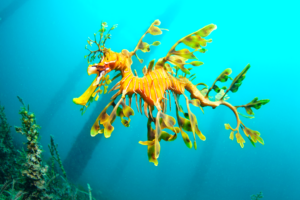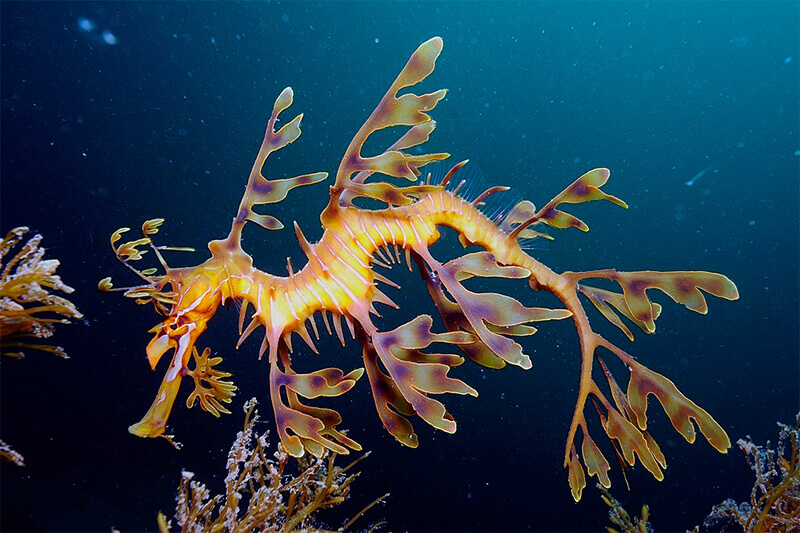Learn all About the Leafy Seadragon

The first thing you may think when you see this animal is that it has been created by someone with a lot of imagination. The leafy seadragon is an expert at camouflaging itself in its environment, as its body perfectly imitates the surrounding vegetation.
You’re looking at one of the most fascinating animals in existence. If you want to know more about its biological makeup, here we’ll bring you some fascinating information to help you get an idea of how it relates to its environment and its way of surviving on this planet. Let’s get started.
Taxonomy and characteristics

The leafy seadragon (Phycodurus eques) is an animal belonging to the Syngnathidae family, which includes seadragons like itself, but also pipefishes and seahorses. It’s the only member of its genus, Phycodurus.
Its name refers to its morphology, which gives it the appearance of being part of the surrounding algae. The long, complex, and flexible protuberances on its body help it blend into the environment, as it usually lives attached to the vegetation on the seabed. Its colors vary from brown to olive green for the same reason.
It usually measures about 30 centimeters (12 inches). In addition to its tube-shaped mouth, it also has sharp spines on both sides of its body, which are a last resort defense against predators.
Habitat of the leafy seadragon
The leafy seadragon inhabits the southern coasts of Australia, from the Abrolhos Islands to western Victoria. There have also been sightings in Bass Strait and Tasmania.
They tend to frequent rocky reefs where seaweed grows. They’re located in waters up to 50 meters (165 feet) deep, close to shore, and around sandbars. Although they’re able to move distances of up to 5 hectares, they’re very slow and exhaust themselves quickly, so their geographic range is somewhat limited.
Feeding
This seadragon is carnivorous and makes intelligent use of its limited mobility. In fact, it tends to stay still among the algae, allowing itself to be rocked by the currents to blend in with its surroundings. In this way, it’s able to stalk its prey, consisting of shrimp, plankton, and fish larvae.
To catch them, it performs a sucking movement with its mouth, expanding a joint at the bottom of its snout. Thus, the prey is absorbed immediately without having time to react.
Behavior of the leafy seadragon
This species usually moves alone or in pairs, depending on the time of year. It’s a very slow swimmer, which needs long rests after each swim and risks death when it struggles against strong currents for too long.
Its activity is divided into short periods, with no preference for night and day, since the environments it frequents usually don’t have too much light.
It spends most of its time among the vegetation where it camouflages itself. It provides shelter and hiding places to wait for prey at the same time. When a predator finds it, it’s often surprised by the aforementioned spines, which gives it a chance to survive.
Reproduction
When looking for a mate, males compete violently with each other for females. Courtship is long and consists of synchronized swimming by the male and, if accepted, also by the female.
The female lays up to 250 eggs, sometimes up to 300, while the male develops a series of ovipositors on his tail. The eggs will be deposited in these and incubated for about 4 weeks. Hatching lasts several days; batches of hatchlings are born and they go out to try to ensure the survival of as many as possible, although the survival rate is only about 5%.
The hatchlings are fully independent and capable of hunting, so there’s no parental care in this species.
Conservation status of the foliaceous sea dragon

Despite being considered Near Threatened (NT), since 2016 it has been categorized as of Least Concern (LC) on the IUCN Red List. However, its numbers continue to decline year after year, as it’s very sensitive to habitat degradation due to its limited ability to move.
Human activities have negatively affected them, especially with sewage and fisheries bycatch. The problem is that these circumstances, as well as disturbances from recreational diving, remain anecdotal and aren’t officially recorded.
Although several areas in its distribution have been protected and the species has been included in Australia’s Biodiversity Conservation and Environmental Protection Act, there’s still much work to be done, as it isn’t internationally or commercially protected. Will we continue to see the leafy seadragon in our reefs?
All cited sources were thoroughly reviewed by our team to ensure their quality, reliability, currency, and validity. The bibliography of this article was considered reliable and of academic or scientific accuracy.
- Pollom, R. 2017. Phycodurus eques . La Lista Roja de Especies Amenazadas de la UICN 2017: e.T17096A67622420. https://dx.doi.org/10.2305/IUCN.UK.2017-2.RLTS.T17096A67622420.en . Consultado el 04 de enero de 2023 .
- Connolly, R. M., Melville, A. J., & Preston, K. M. (2002). Patterns of movement and habitat use by leafy seadragons tracked ultrasonically. Journal of Fish Biology, 61(3), 684-695.
- Martin-Smith, K. M., & Vincent, A. C. (2006). Exploitation and trade of Australian seahorses, pipehorses, sea dragons and pipefishes (family Syngnathidae). Oryx, 40(2), 141-151.
This text is provided for informational purposes only and does not replace consultation with a professional. If in doubt, consult your specialist.